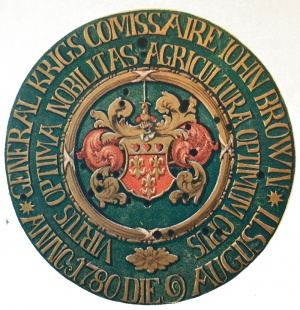Brown, John
Born 1723 in Edinburgh, died 1808. (Marcussen)
Family
Father: Brown, William (Hauch-Fausbøll 1930:10)
Brother: Brown, David (Marcussen) and Brown, William 3 (Hauch-Fausbøll 1930:16)
Son: Brown, William; Brown, James 2 (Marcussen)
Many children...
Father-in-law: Appleby, Peter
Timeline
1746 - Arrived in Denmark - became employed at the trading House of Nicolai Fenwick in Elsinore where he rose to the rank of Fuldmægtig. (Marcussen)
1750 - Arrived in Copenhagen. (Bech 1981:152) Engquist argues he came to Denmark in 1746 already (Engquist 1951, 90)
Purchased cotton at the Asiatisk Kompagni auctions in the 1750s (RA, Moltke)
1755 - Citizenship as Grosserer (Marcussen). This is also the year in which he established his own merchant house (Engquist, 1951, 90)
1756-10-20 - Married to Applebye, Anna (1738-1798) (Marcussen) The wedding took place in Reformert Kirke. (BioLek II)
1759 - Partnered with his brother Brown, David and founded the trading House of John & David Brown. (Marcussen)
1766 - Listed as engaged in Speculations=, Commissions= samt Vexelhandel. and trading on the West Indies. (Holck: Dannemarcks Handels=Speil 1766:69)
1770-1772 - Director of Asiatisk Kompagni (Glamann, 1947)
1778 - Bankrupted. (Bech 1981:342)
1779 - Director of Asiatisk Kompagni till 1785. (Marcussen)
1780 - Gave a painted target to Det kongelige Kjøbenhavnske Skydeselskab. (Reitzel 1897:16)
1781 - Bought the shipyard behind Frederiks Tyske Kirke for his son Brown, William. (Marcussen)
1782 - Partnered with his son Brown, William in the House of John & William Brown & Co. (Marcussen)
Property
Owned the estate at Vingaardsstræde 137, in the inner city of Copenhagen. It had previously belonged to Grevinde Reventlow, when he bought it in 1757. Already by 1783 it was necessary for him to sell almost all of his personal belongings, including the property on Vingaardsstræde no. 137, which he sold to the wine merchants Søren Kolstrup and Ditlef Bøhling (Engquist 1951, 90). This estate also formed the framework of some public auctions of goods coming in from India (Auktionsregnskaber, AK, the years 1795 is the earliest mention). The auction would have taken place in a house based on the "courtyard" (gaarden) of the property, and is likely the half-timbered house which Engquist believes to have been built in 1716, and in the time of John Brown, having been used mostly as a "warehouse"
